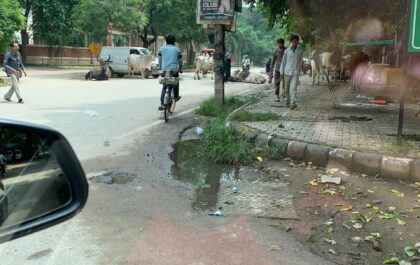On the morning of October 24, 2024, I set out for my regular walk, eager to embrace the fresh air and tranquillity of the early hours. However, this morning greeted me with a starkly different atmosphere. As I stepped outside, I was immediately struck by the presence of smog. It was clear that the atmosphere was heavily polluted, likely a result of increased vehicular emissions, stubble burning, and industrial activities. The usual crispness of the morning air was replaced by a slightly acrid, unpleasant scent that made breathing less comfortable.
The winter season brings significant changes to the landscape and the rhythm of life in many parts of the world, especially in agricultural regions. This time of year is marked by shorter days, cooler temperatures, and often, a period of dormancy for many plants. However, in agricultural communities, particularly in parts of India like Punjab and Haryana, winter is a crucial time for preparing the fields for the next crop cycle. Unfortunately, one common practice associated with this preparation—burning crop residue, or stubble—has severe environmental repercussions, contributing significantly to air pollution and posing health risks to humans and other living beings.
Addressing the issue of stubble burning requires a multi-faceted approach involving both individual actions and government policies.
1. Adopting Alternative Practices: Farmers can be encouraged to adopt sustainable agricultural practices. Alternatives to burning include:
• Incorporating Residue into Soil: Using machinery like the Happy Seeder, which sows seeds without removing stubble, thus incorporating it back into the soil.
• Composting: Converting crop residue into compost can enrich the soil and reduce waste.
• Biochar Production: Crop residue can be converted into biochar, a form of charcoal used to improve soil health and sequester carbon.
2. Community Awareness: Raising awareness among farmers about the health and environmental impacts of Stubble burning can lead to more conscientious decision-making. Educational programs and community initiatives can play a crucial role in this regard.
3. Utilising Government Schemes: Taking advantage of subsidies and support provided by the government for sustainable farming equipment and practices can alleviate the financial burden on farmers.
Government Policies
1. Strict Enforcement of Laws: Implementing and enforcing strict regulations against parali burning is essential. Offenders should face penalties. Farmers should be Educated to promote compliance.
2. Subsidies and Incentives: Providing financial incentives for farmers to adopt alternative methods can make sustainable practices more attractive. Subsidies for purchasing equipment like the Happy Seeder or for implementing composting systems can encourage farmers to move away from burning.
3. Research and Development: Investing in research to develop new technologies and practices for managing crop residue can provide long-term solutions.
4. Infrastructure Support: Building the necessary infrastructure to support alternative practices is crucial. This includes composting facilities, biochar storage, and service centres for renting sustainable farming equipment.
Dealing with Defaulters
A balanced approach is needed when dealing with individuals or entities that continue to burn stubble despite regulations and available alternatives.
1. Monitoring and Reporting: Implementing systems for monitoring air quality and reporting incidents of Stubble burning can help authorities respond swiftly. Satellite imagery and drones can be used for effective surveillance.
2. Fines and Penalties: Imposing fines on those who violate burning bans is necessary to deter the practice. However, penalties should be proportional and consider the economic challenges faced by small-scale farmers.
3. Support Programs: Offering support programs for defaulters to transition to sustainable practices can be more effective than punitive measures alone. This might include providing access to alternative technologies, financial aid, and educational resources.
Community Involvement: Encouraging community involvement in monitoring and promoting sustainable practices can create a sense of collective responsibility. Farmer cooperatives and local organizations can play a key role in this process.

Popular Stories
Football Tournament @Princeton
More Than a Festival: The Art and Power of Durga Puja
Personality of the Month- ‘Dr Usha Mediratta’
Stray Cattle Menace In Front of Galleria
The Chronicles of Malibu Towne: A Mosquito’s Tale
“Senior Living Is Not An Old Age Home” say Mr & Mrs Bose
Recent Stories from Nearby
- Araya Samaj Hauz Khas New Delhi December 27, 2024
- AGM At Adhya Jha December 27, 2024
- Petty Thefts on the Rise December 27, 2024
- Water Sprinklers in SDA December 27, 2024
- Town Hall Meeting With Parmila Tokas December 27, 2024







